
Wash or brush up? Caring for Elizabethan clothing.
In our throw away age of fast fashion, it’s hard for us to comprehend just how expensive clothing was in Elizabethan England. In her book Tudor Fashion, Eleri Lynn tells us that Robert Dudley, Earl of Leicester (1532-1588) spent more for one suit of clothes that William Shakespeare paid for a house in Stratford-on-Avon less than ten years later.

Image via Wikimedia Commons Robert Dudley, 1st Earl of Leicester Anglo-Netherlandish School, Unknown Artist NPG
This level of spending does not seem to have been out of the ordinary for Dudley. In a letter to William Davison, the English representative at the court of the Prince of Orange in the Netherlands, on 25 April 1579, he wrote:
— if there be any good cloth of tissue, or of gold, or such other pretty stuff, to stay for me to the value of £300 or £400, whatever the charge shall be.
If my maths is correct, using the National Archives currency calculator, £400 in 1579 is the equivalent of £81,821.88 in 2017. It would take a skilled tradesman in Elizabethan England 8,000 days to earn that sum — around 29 years.
Admittedly Elizabeth’s ‘sweet Robin’ liked to dress to impress, but silk velvets, cloth of gold or silver, lavishly embroidered and often imported cloth, really did cost a fortune, not to mention the tailor’s bills for creating garments in the latest fashion.
Some colours were especially expensive. For example, achieving a true black colour as worn here by William Cecil, Lord Burghley, as opposed to a wishy-washy, non-colour-fast black, required several imported dyes and dyeing processes, which increased the cost.
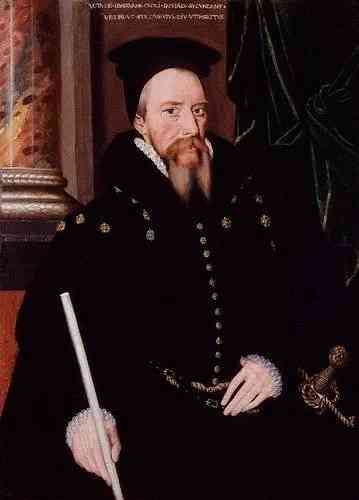
Image via Wikimedia Coimmons; Protrait of William Cecil, Lord Burghley,by an unknown artist NPG
Today, when even the Princess of Wales sometimes wears skinny jeans, clothing is much less a signal of status and class than it was in Elizabethan England. Sumptuary laws restricted some colours and fabrics to the elite. What you wore defined who you were. Royalty used clothing to display magnificence and power, while the wealthy relied on their elaborate and opulent clothes to reinforce their position in society. This came at huge cost. In my novel ‘A Woman of Noble Wit’ I have Sir Philip Champernowne bemoaning the burden his tailor’s bill is placing on his purse.
If you spent that much on those grand gowns, doublets or cloaks, you would not want to risk ruining them by dunking them in the river or into a vat of steaming water heated in a copper. Nor would you want to beat them with sticks or force out stains with lye, a caustic alkaline liquor made by steeping woods ashes in water, or with soap made by boiling lye with fat. People sometimes added urine as a bleach, while they also helped the bleaching process by drying linen outside, draping it over bushes or on the grass, and exposing it to sunlight. (I hang my shifts on a washing line as pictured, but I haven’t yet found a reference to washing lines being used in the sixteenth century.)
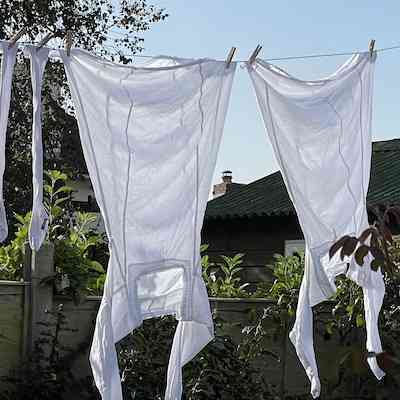
Photo Linen shifts drying on my own washing line
A wealthy woman’s laundry maids could treat underwear in this way and keep her in a constant supply of clean linen. But how on earth did the Elizabethans keep their expensive top clothes clean and fresh?
Underpinnings
Linen underwear — the ubiquitous shift, smock or shirt, worn by men and women of all classes next to the skin — was the first line of defence. It absorbed sweat and grease and kept such stains away from the costly outer layers.
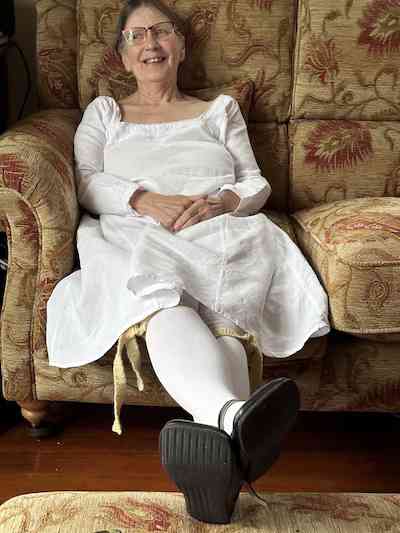
Photo my own - taking a break in my underpinnings
Having spent so much time dressed in Elizabethan style, I can testify that this really does work. My gowns are spared and the more often I wash my linen, the softer and more comfortable it becomes.
The Elizabethans constructed their undergarments to withstand frequent washing, ensuring that there were no raw edges left at seams. They often used flat-fell or French seams, or my preferred method of hemming each section of the garment separately and then whip-stitching them together. Linen cloth could be fine and expensive (such as Holland) or more coarsely woven and somewhat cheaper. Ripping out and replacing gussets under the arms when they get soiled could extend the life of the garment. Nothing went to waste even after the fabric had worn too thin for further wear, linen scraps were used to make paper.
Linings
Linen was often used to line gowns, bodies, doublets, partlets (scarf-like garments that sat on the shoulders), and waistcoats (the term for any short jacket - not the sleeveless item we know today). Should any stains seep through or if the lining becoming worn, they replaced it.
Storage
Clothing was stored in stout wooden chests, known as coffers.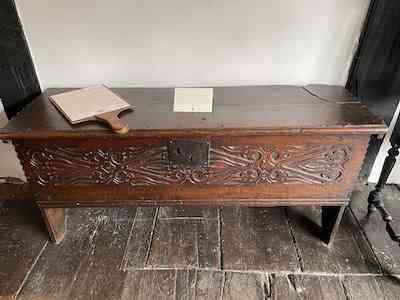
Photo my own taken at The Tudor House Museum, Worcester.
Damp and mildew were often a problem. Records show that in the Royal Wardrobe, they burned large quantities of coal and wood to keep the atmosphere dry where the queen's clothes were stored. At regular intervals they took out the clothing, inspected it, and aired it. Amongst the clothes, they placed "sweet bags" containing powders perfumed with things like powdered oris root, violets, musk, ambergris, or "damask powder fyne" (made from rose petals). Within the chest, they might wrap clothing to keep it free from dust, and they sometimes keep it in bags made for the pourpose. The sweet powder mixtures may also have helped to keep moths away William Turner, in a herbal printed in 1568 recommends the ‘citrone appel’ (lemon or a lemon like citrus fruit).
Removing stains
People spilled food from time to time and garments got stained. Several helpful advice guides were available for Tudor and Elizabethan housewives, offering a range of methods to remove stains from high status fabrics. In 'The Tudor Housewife', Alison Sim mentions 'The Profitable Book Declaring Dyvers Approved Remedies', which suggests that Tudor and Elizabethan housewives should wash both silk and gold fabrics in heated water. They would then add soap to the water and allow it to melt. After the water had cooled down, they could wash the garment and then dry it with dry cloths placed between the layers. Other suggested remedeies include dabbing a solution made by soaking the leaves of the herb, soapwort (Saponaria officinalis), onto grease spots or applying Castille soap(a scented soap made from olive oil) with a feather. Alternatively, using a solution of fullers earth on woollens, skins and furs) , or even water in which peas had been soaked, might get stains out. Another rather alarming solution, suggested in a book by John Partridge ‘A Treasury of Commodities and Conceits’, was to use a mixture including raw red arsenic.
Brushing and shaking
Woollen items were brushed every week and shaken out to keep moths at bay. Other garments were brushed regularly. Skinners mended, trimmed and beat furs to keep them in good condition. They sprinkled furs that had hardened with wine, left to dry and then rubbed until soft.
I have found brushing a very successful way to remove surface dust and keep my Elizabethan gowns in good order.
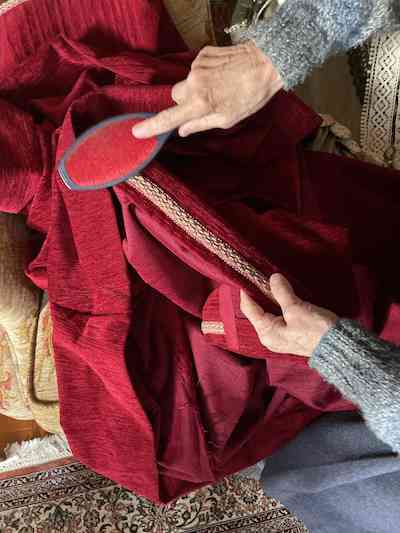
Photo my own brushing my Elizabethan gown (I do not use an authentic sixteenth century brush.)
This must have been time-consuming work, and care wold be needed to avoid damaging fine stitch-work and trimmings. Queen Elizabeth’s wardrobe and household accounts reveal she paid the queen’s brushers to carry out this task.
In 1583 Robert Pamplin was appointed Brusher of our Robes’ and, and paid three pounds for half a year of ‘ his great travail and paynes’. By 1585, his pay had increased to five pounds per half year, and he was doing some mending and altering. By 1587, his role had expanded to include some laundry duties, too. He was paid for washing and starching 13 pairs of sleeves, and 26 yards of holland cloth, for washing and starching 19 pieces of cutwork to draw out gowns, for washing and starching one forepart and one face for a gown of drawn cutwork, and for making nine curtains of holland cloth. In 1588 he was promoted to the post of Page of the Robes, in 1598 to Groom of the Robes and in 1603 to Yeoman of the Robes — quite a career progression.
Outfits in a multitude of parts
A fashionable lady’s complete ensemble came in many parts with separate sleeves (often with two or more parts (fore-sleeves and upper sleeves), collars, ruffs, partlets, cuffs, placards/stomachers, and forepart (central panel that showed beneath a split skirt.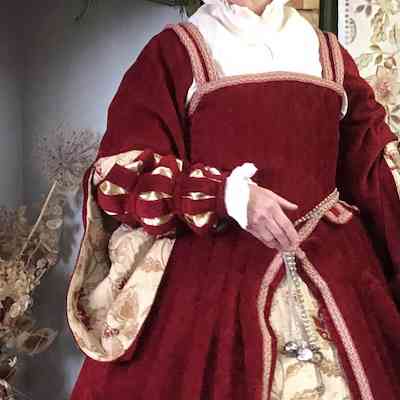
Photo my own; red sleeves in three parts
This meant that if, for example, a sleeve was stained beyond cleaning or otherwise damaged, they could remove the damaged sleeves and simply add new oneswithout having to sacrifice a complete gown.
This went for all the constituent parts and was also an easy way to update an outfit to follow the latest fashion trends and multiple options for mix and match.
Men often wore doublets with separate sleeves, and hose came in two or more parts. They also had the option to add cloaks and over garments.
If a larger area of cloth, like in a skirt, got stained or damaged beyond repair,it was cut up and they could then use any good cloth to make something new, like children's clothing or household items such as cushion covers.
Mending, alteration and repairs
The hems of long skirts often wore out because of dragging on the ground. To remedy this, they stitched a binding strip of fabric, called a keeper, to the hem. I will soon have to put this into practice for my favourite red gown, which gets a lot of wear, particularly in the run up to Christmas. Keepers could be of contrasting colour or more hard wearing fabric. a keeper was also a good way to lengthen a gown for a growing girl.
Clothing was often remodelled with new trims and edgings added or moved. There was a brisk trade in second hand clothing, which could be altered to fit the new owner.
Women's clothes do not seem to have used buttons frequently, but buttons from men’s doublets, etc.could be matched and replaced missing
During the later part of the century, knitted hose became popular in both fine wool and silk. It was possible to darn them.
Main sources;
Alison Sim - The Tudor Housewife
Janet Arnold - Queen Elizabeth’s Wardrobe Unlocked
Eleri Lynn Tudor Fashion